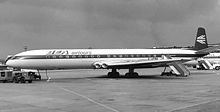Summary Terrorist Bombing Passengers 59 Fatalities 66 Date 12 October 1967 Passenger count 59 | Crew 7 Survivors 0 Number of deaths 66 Survivor 0 | |
 | ||
Similar Aeroflot Flight 2230, Lake Central Flight 527, 1967 Nicosia Britannia, TWA Flight 128, Piedmont Airlines Flight 22 | ||
Cyprus Airways Flight 284 was a de Havilland Comet that broke up during a flight to Nicosia International Airport on 12 October 1967, after an explosive device detonated in the cabin. The airliner crashed in the Mediterranean Sea and all 66 passengers and crew members on board died.
Contents
Aircraft
The aircraft was a de Havilland DH.106 Comet 4B, registration G-ARCO, the 49th Comet 4 built. It had been owned and operated by British European Airways (BEA) since it was built in 1961.
Flight
BEA was a shareholder in Cyprus Airways, and the two airlines had an agreement in place for all of Cyprus Airways' jet services to be operated by BEA Comets. Late on the day before the crash the aircraft departed on a night-time BEA service from London Heathrow Airport to Ellinikon International Airport in Athens, Greece, arriving just after 3:00am local time (1:00am UTC) on 12 October. At about 4:30am the aircraft departed Athens on the regular Cyprus Airways flight to Nicosia in Cyprus with 59 passengers and a crew of seven on board.
About 45 minutes into the flight, control of the aircraft was transferred from air traffic controllers (ATC) at Athens to their counterparts at Nicosia. The crew contacted Nicosia's controllers by radio, but when ATC replied there was no response from the aircraft.
The flight was due to go on to Cairo after Nicosia. Eight passengers had to take a MEA flight the next day.
Recovery of remains and wreckage
A total of 51 bodies were recovered from the sea within a day of the crash, most wearing life jackets and some wearing wristwatches that had stopped at 5:25. Investigators concluded that the aircraft had suffered some form of damage during the initial radio call to Nicosia ATC at about 5:15am and had broken up in flight about eight minutes later. They estimated the aircraft's wreckage to be scattered on the seabed over an area of about 35 square miles (91 km2) at a depth of 9,000–10,000 feet (2,700–3,050 metres) below the surface.
After a drop tank was recovered from the sea, investigators hypothesised that the aircraft crashed due to a mid-air collision with a military aircraft. However searchers also found a cushion from one of the Comet's passenger seats floating on the surface of the sea, which on examination was found to have evidence of an explosion. Analysis of the seat cushion showed traces of a military plastic explosive. After this find the mid-air collision theory was discarded and a decision was made not to retrieve any submerged wreckage.
Conclusions
The seat cushion and other recovered objects from the Comet's passenger cabin were analysed by the Forensic Explosive Section of the Royal Armament Research and Development Establishment, the first time that this was done.
As Flight 284 was flying towards Cyprus at Flight Level 290 [an altitude of approximately 29,000 feet (8,839 m)], the aircraft broke up in mid-air about 100 miles (161 km) southeast of the island of Rhodes in Greece and about 22 miles (35 km) south of the Turkish coastal town of Demre.
